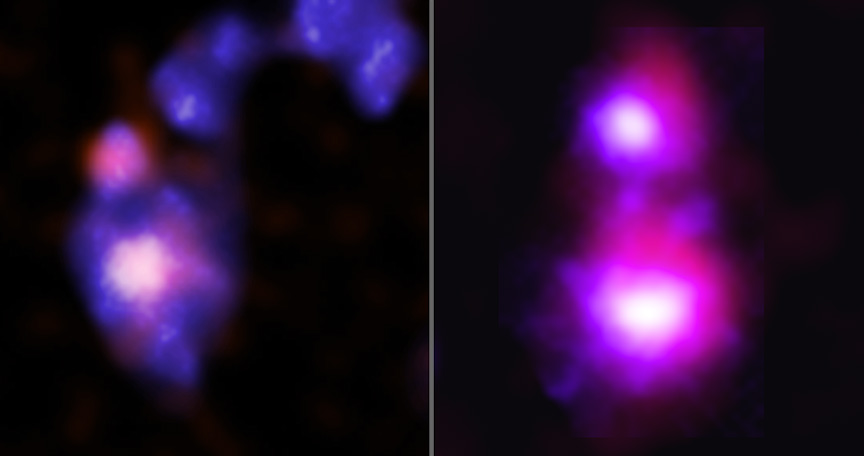The universe is a vast and mysterious place, constantly surprising us with new discoveries that challenge our understanding of cosmic evolution. This event, captured by NASA’s Chandra X-ray Observatory, offers a unique glimpse into the early universe’s chaotic dance of galaxies and black holes. What does this mean for our understanding of the cosmos? Let’s unravel the secrets behind this extraordinary find.
The Significance of Dual Black Hole Pairs
The presence of dual black hole pairs in these merging galaxies offers a unique window into the violent and transformative processes that shaped the early universe. Each galaxy houses two supermassive black holes, a scenario never before observed. This rare occurrence could be a crucial missing piece in understanding how galaxies, including massive ones like our Milky Way, evolve over time through mergers of smaller galaxies.
The observed galaxies, Mirabilis and Elstir & Vinteuil, are dwarf galaxies, which are thought to be the building blocks of larger galaxies.

By studying these mergers, scientists hope to understand how dwarf galaxies contribute to the growth of massive galaxies. When black holes merge, they release enormous amounts of energy, potentially altering star formation rates and even ejecting stars from the galactic core.
Capturing the Moment: Chandra’s Role in the Discovery
NASA’s Chandra X-ray Observatory played a pivotal role in capturing this cosmic event. Chandra’s powerful X-ray imaging capabilities allowed astronomers to observe the high-energy emissions from the black holes’ accretion disks, where gas and dust swirl at near-light speeds before plunging into the black holes. These X-ray emissions are critical markers that not only confirm the presence of black holes but also provide insights into the intense gravitational interactions that characterize galactic mergers.
The merging process observed in these two galaxies can be likened to a cosmic dance, where each black hole pair orbits closer and closer, eventually colliding in a spectacular burst of energy. This dance is not just a visual spectacle; it is a vital process in the evolution of galaxies. As the galaxies merge, their gravitational forces interact in complex ways, redistributing stars, gas, and dark matter. The result is the creation of larger, more mature galaxies over billions of years.
Galactic Mergers and the Evolution of the Universe
Galactic mergers are one of the primary mechanisms driving the growth of galaxies in the universe. When galaxies collide, they trigger bursts of star formation, alter galactic structures, and fuel the growth of supermassive black holes at their centers. This process is fundamental to the cosmic evolution we observe today, and the discovery of merging black hole pairs in dwarf galaxies offers a closer look at these transformative events in action.
The presence of two supermassive black holes in each galaxy raises questions about how such massive objects can coexist and eventually merge. These dual black hole systems provide a unique opportunity to study the gravitational dynamics that lead to black hole mergers. Understanding these processes could help explain why most large galaxies, including our own Milky Way, harbor a single supermassive black hole at their centers—a likely remnant of past mergers.
What This Discovery Teaches Us About the Early Universe
This unprecedented discovery also sheds light on the conditions of the early universe. Dwarf galaxies like Mirabilis and Elstir & Vinteuil are considered the progenitors of larger galaxies, suggesting that the early universe was filled with smaller, interacting galaxies. The dual black hole pairs observed in these galaxies may represent a critical phase in galactic evolution, offering clues about how supermassive black holes formed and grew during the universe’s infancy.
Future Research and Observations
The study of these merging black hole pairs is just beginning. Future observations with telescopes like the James Webb Space Telescope and the Extremely Large Telescope will provide even more detailed views of these interactions. Follow-up studies will aim to measure the gravitational waves produced by these mergers, which could offer a new way to study the invisible forces at play in the universe.
Despite the excitement, this discovery raises several challenges and unanswered questions. How common are dual black hole pairs in merging dwarf galaxies? What role do these interactions play in the broader context of cosmic evolution? And could similar events have shaped the early history of our own galaxy? Answering these questions will require continued observations and theoretical modeling, but each discovery brings us closer to understanding the complex dance of galaxies and black holes that has shaped the universe.
Conclusion: Unraveling the Mysteries of Cosmic Evolution
The discovery of two dual black hole pairs in merging dwarf galaxies is more than just a cosmic spectacle—it’s a crucial piece in the puzzle of how our universe evolved from its chaotic beginnings to the structured cosmos we observe today. These findings highlight the importance of galactic mergers in shaping the universe and underscore the dynamic and ever-changing nature of cosmic evolution. As astronomers continue to study these rare events, we can expect to learn even more about the forces that drive the growth of galaxies and the black holes at their centers. Let’s unravel the secrets of the universe, one cosmic dance at a time.
Reference:
Micic, M., Holmes, O. J., Wells, B., & Irwin, J. A. (2023). Two candidates for dual AGN in dwarf-dwarf galaxy mergers.



















